Advisory Committee on Senior Level Retention and Compensation (Stephenson Committee)
Archived information
Archived information is provided for reference, research or recordkeeping purposes. It is not subject à to the Government of Canada Web Standards and has not been altered or updated since it was archived. Please contact us to request a format other than those available.
The Honourable Vic Toews, M.P., P.C.
President of the Treasury Board
House of Commons
Ottawa, On K1A 0A6
Dear Minister Toews:
As promised in our letter to you of March 2007, our Committee is providing a full report with recommendations to help the government build momentum and maintain excellence in the human resources management of senior levels.
Before we begin, the Committee wishes to congratulate the government on the implementation of our most recent recommendations for senior level compensation increases. We are particularly pleased that the government implemented our recommendation to provide a greater compensation increase for higher level executives through increases in performance pay. Since this Committee began its work in 1998, executives have received timely compensation increases to maintain executive compensation at a level intended to support the government's recruiting and retention needs.
We believe that Canada needs good public policy to be globally competitive, and that to have good public policy, the public service needs the best people. Our report and recommendations will assist you and the government to maintain and promote the excellence that has made Canada's public service among the finest in the world.
We request a meeting with you and your colleagues to discuss this report and the work of our Committee as soon as possible.
The paper version was signed by
Carol Stephenson
CC: Kevin Lynch, Clerk of the Privy Council and Secretary to the Cabinet
Chair:
Carol M. Stephenson
Dean
Richard Ivey School of Business
Members:
Jay Forbes F.C.A.,
EVP & President, EMEA,
Ingram Micro
Gaétan Lussier
President
Gaétan Lussier and Associates
Patrick O'Callaghan B.A., M.B.A.,
President, Patrick O'Callaghan and Associates
Sarah E Raiss
Executive Vice-President, TransCanada Corporation
Raymond Royer L.L.B., M.A.,
President and CEO, Domtar Inc.
Contents
- Let the Leaders lead
- Maximizing the total value proposition
- Crown Corporations
- Branding
- The Clerk's priorities
- Summary of recommendations
- Progress since March 2007
- Appendices
- Appendix One: Advisory committee members
- Appendix Two: Mandate of the advisory committee
- Appendix Three: March 2007 letter
Let the Leaders lead
In our last letter to you, we said: "Let the leaders lead." Senior executives must be given the direct accountability and scope to manage people more effectively.
As illustrated below, the Management Accountability Framework (MAF), as the definition of the government's vision of good management, sets out the conditions that need to be in place to ensure the government is well-managed and clarifies the scope and accountability of deputy heads. The MAF is also a critical element of deputy head assessment. MAF-based assessment should be cascaded down to all executive levels in the organization. In this way, the MAF will assist the public service to meet the challenges and to deliver on the government's commitments.
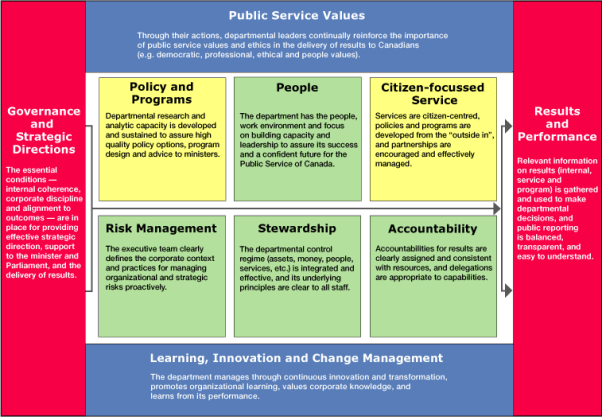
Public Service Values – Text version
Potential shortage of talent at the Executive level
In terms of the future of the public service, there is every reason to be concerned. The annual retirement rate for executives is projected to increase markedly in the next few years. When this committee first began its work in 1996-1997, the retirement rate was 1.7 per cent. It had reached 3.8 per cent in 2002-2003, and is projected to more than double, reaching a high of approximately 10 percent in 2008-2009 before beginning to drop. Based on interviews, Assistant Deputy Ministers (ADMs) intend to leave at a stable rate of 10 to 15 per cent per year (30 to 40 ADMs) for the next 3 to 5 years. During this same period, departures for other reasons, such as voluntary departures are also expected to increase. The graphs that follow tell much of the story.
Note: The Canada Public Service Agency is the source of data for all the graphs that follow. With the exceptions of Graphs 3 and 4, demographic data is based on the population of the Core Public Administration. Graphs 3 and 4 reflect data from a wider population including the Core Public Administration, the Canada Revenue Agency, the Canadian Food Inspection Agency, the Canadian Security Establishment, and the Canadian Security Intelligence Service.
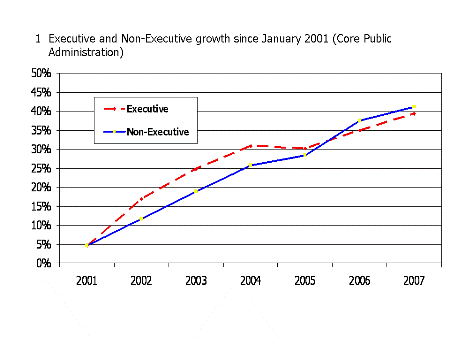
Display full size graphic - 1. Executive and Non-Executive growth since January 2001
Graphic 1: Executive and Non-Executive growth since January 2011 – Text version
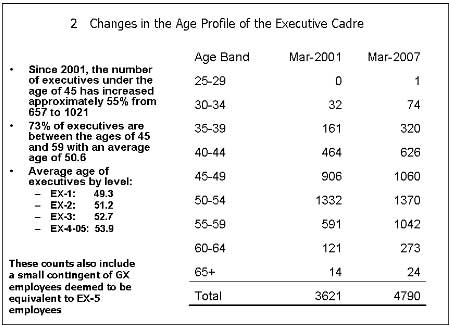
Display full size graphic - 2. Changes in the Age Profile of the Executive Cadre
Graphic 2. Changes in the Age Profile of the Executive Cadre – Text version
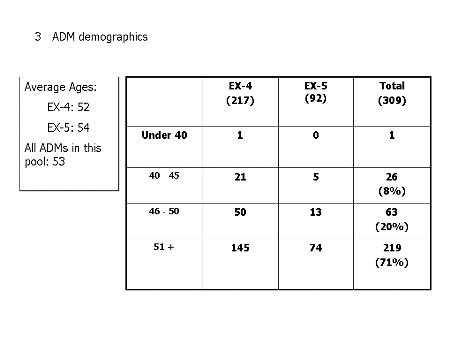
Display full size graphic - 3. ADM demographics
Graphic 3. ADM demographics – Text version
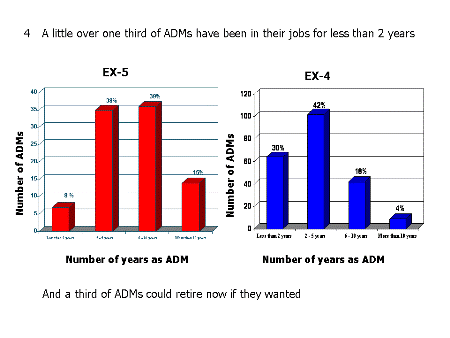
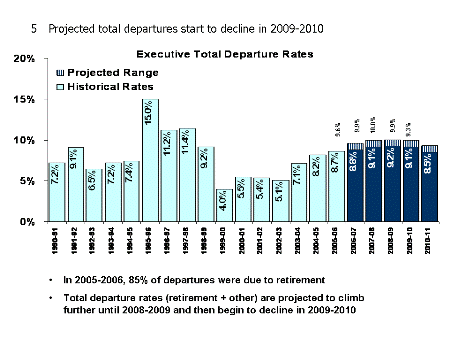
Display full size graphic - 5. Projected total departures start to decline in 2009-2010
Graphic 5. Executive Total Departure Rates – Text version
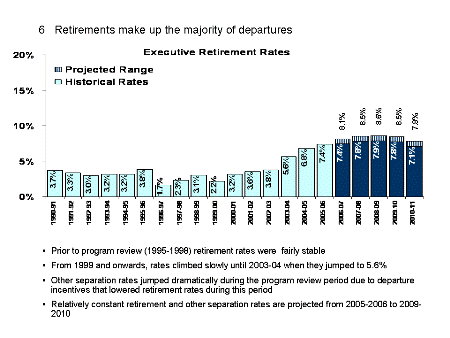
Display full size graphic - 6. Retirements make up the majority of departures
Graphic 6. Executive Retirement Rates – Text version
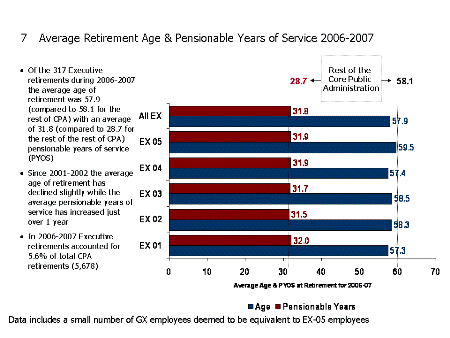
Display full size graphic - 7. Average Retirement Age & Pensionable Years of Service 2006-2007
Graphic 7. Average Retirement Age & Pensionable Years of Service 2006-2007 – Text version
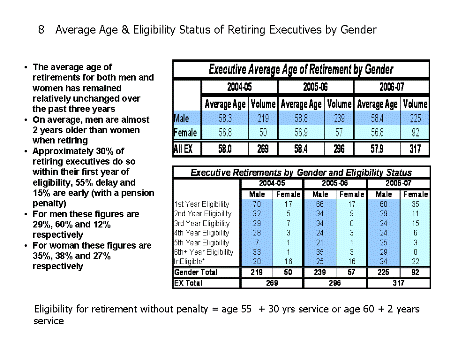
Display full size graphic - 8. Average Age & Eligibility Status of Retiring Executives by Gender
Graphic 8. Average Age and Eligibility Status of Retiring Executives by Gender – Text version
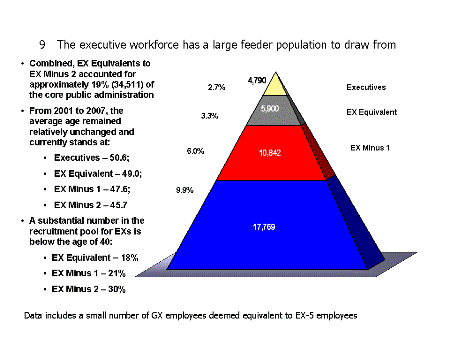
Display full size graphic - 9. The executive workforce has a large feeder population to draw from...
Graphic 9. The executive workforce has a large feeder population to draw from – Text version
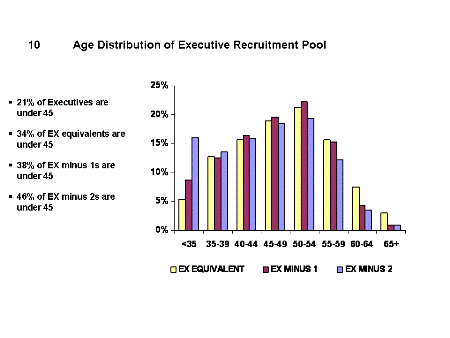
Display full size graphic - 10. Age Distribution of Executive Recruitment Pool
Graphic 10. Age Distribution of Executive Recruitment Pool – Text version
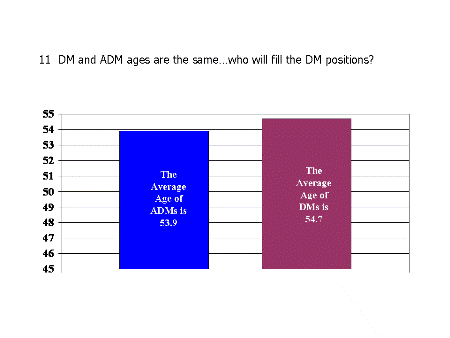
Display full size graphic - 11. DM and ADM ages are the same…who will fill the DM positions?
Graphic 11. Comparison of ADM and DM Average Ages – Text version
The demographics point to a need for action to ensure business continuity and ongoing renewal of the Public Service.
In particular, attention needs to be paid to the fact that the average age of the ADM pool is 54. The DM pool has a similar average age. With retirement eligibility at 55, there is potential that the likely replacements will retire during a similar timeframe. In addition, the average age of EX-3 is 52.7, the likely group to replace ADMs. At the senior levels of the executive ranks, there is significant age compression.
The Clerk of the Privy Council, in his 14th Annual Report to Parliament, addressed four important themes in the renewal of the Public Service:
- planning
- recruitment
- employee development
- enabling infrastructure
These are all essential to our theme of letting the leaders lead. In this report, our Committee discusses trends and issues in human resources management for senior levels that the Government will need to address. These issues are not unique to the Government – employers across Canada are also dealing with them: retention, employee engagement, and branding the organization to make its mission clear and to attract and retain high caliber personnel. We will speak to specific areas related to the mandate of our Committee then comment on how our priorities fit with the Clerk's priorities.
Maximizing the total value proposition
While our recent reports and recommendations have had a focus on compensation, our broader mandate is the human resources management of senior levels. We are taking an employee-centered approach to human resources management by focusing on the total value proposition. By this term, we mean the sum of all the factors – the pay, the experiences, the benefits, pension, and other rewards - that employees consider to be good value in exchange for their efforts, and that influence employees' decisions to join, stay, or leave an organization. The total value proposition is different for every employee, but it includes elements such as:
- Compensation, pension and benefits
- Personal growth and opportunity to make a difference
- Recognition of effort and a job well done
- Stability of employment/work environment
There is a simple equation behind the total value proposition: when employees' perception of the total value proposition is positive, they join and stay with the organization; when it is negative, they begin to look for alternatives or leave.
The total value proposition requires a focus on issues beyond compensation. There is a need for constant vigilance to ensure that the total value proposition is positive for skilled and experienced senior level employees and that current and prospective executives are aware of and satisfied with what employment in the federal government offers them as a total value proposition.
If the federal government is to be one of Canada's top employers, it is necessary to consider the more important elements of the total value proposition and look at the tools the government has to sustain them.
Value proposition element 1. Compensation and benefits
Compensation that is appropriate to the government's recruiting and retention needs is an important element of the total value proposition and an equally important tool to help attract and retain qualified and experienced employees. To be effective attraction and retention mechanisms, salary structures must be appropriately positioned vis à vis the so-called feeder groups. This is critical to ensure that non-executive employees are encouraged to consider careers as executives, to do the learning and additional work, accept the additional responsibilities, and, in light of the complex challenges they face on a day to day basis, to take the risks.
Our Committee places high importance on continuing to benchmark with the Canadian labour market. Our recommendations on senior level compensation to date have ensured that compensation for senior levels is competitive. As a result, the total compensation of executives is somewhat above the broader public sector.
Compensation should also be comparable to what executives in similar positions in the rest of the Canadian labour market receive and should recognize the individual contribution of senior public servants. These demands are considerable. Paul Tellier, in a recent interview, commented that in comparison with working in the private sector, "managing in the public sector is more complex. You have far more stakeholders, the objectives are more multi-dimensional. While CEOs have focused on the bottom line, the public service has dealt with sustainability issues, diversity, the environment."See footnote[1]
The current compensation structure, consisting of salary ranges and performance pay for senior levels, was implemented in 1998, and it was an adequate tool for the retention challenges facing the government at the time. It is nearly a decade since that structure was put into place. With labour market and demographic challenges facing the public service, the focus of the government has changed. We now need to consider whether the current compensation structure needs adjustments to facilitate mid-career recruitment and to address specific skill shortages at senior levels.
Considerable progress has been made since 1998. Before the current compensation structure was put in place, there had been downsizing, a number of successive years of zero salary increases, morale was low, and the prospects for attracting new executives was poor.
Since then the government has implemented the current salary structure and provided regular annual increases. We can report with confidence that at least at the level of entry into the EX Group (EX-1), total compensation is equivalent to the median of what an executive with equivalent responsibilities and qualifications would be earning in the Canadian labour market.
We have noted in a number of our past reports that while the structure is situated appropriately with the Canadian labour market at the EX-1 level, it falls behind the labour market at higher levels. The most senior levels of public service executives are making less than their private sector counterparts who have very similar duties and responsibilities. This is illustrated in the following graph.
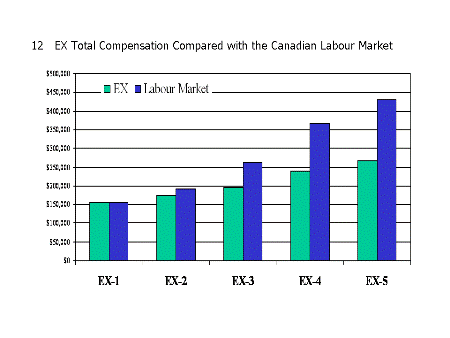
Display full size graphic - 12. EX Total Compensation Compared with the Canadian Labour Market
Graphic 12. EX Total Compensation Compared with the Canadian Labour Market – Text version
As well, total compensation is behind the Canadian labour market at the DM-2 level, as illustrated in the following graph.
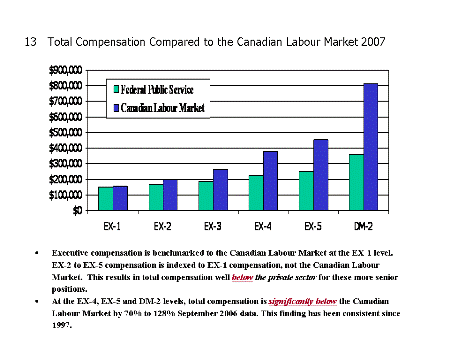
Display full size graphic - 13. Total Compensation Compared with the Canadian Labour Market
Graphic 13. Total Compensation Compared to the Canadian Labour Market 2007 – Text version
We are particularly pleased to note that the government has agreed with our recommendation to put some of the compensation increase for 2007-2008 into performance pay to support the recognition of good performance and to begin to address the gap with the Canadian labour market at higher levels of the executive cadre. We recommend that this practice continue.
Performance pay should be used as a tool towards achieving excellence. There should be rewards for achieving excellence, both what and how results are achieved. In order to modernize this element of the total value proposition, we will consider whether all or a portion of future increases in total compensation should be allocated to performance pay, specifically the portion of performance pay that is allocated to the management of people. This will allow the government to focus executives on the important business of leading and valuing people, rewarding those who excel in the management of people. This approach also makes the cash compensation of public service executives more like that of the private sector, where typically a larger proportion of salary has to be re-earned annually.
We are encouraged that the performance management program results continue to improve. Not all executives receive the maximum and not all executives receive performance pay. The government's application of the program is best practice and the Committee is satisfied with the distribution of performance pay in the various categories. The government continues to publish results of the performance management program. We commend this effort and recommend that it continue, in the interests of transparency and to ensure that executives see performance pay as part of the total value proposition.
Other elements of compensation such as vacation, other leave provisions and severance paySee footnote[2] cannot be ignored. The government needs to offer a value proposition that is appropriate to executives at different career-stages and that supports mid-career entry to senior levels. In our Seventh Report we recommended a review of the terms and conditions of employment for executives. We are pleased to note that the Canada Public Service Agency (CPSA) has completed the review and has issued a revised set of policies.
Together with appropriate compensation, these revised policies on the management of executives provide deputy heads with greater flexibility to recruit and manage their executives. To quote Paul Tellier again: "In business, if you want good people, you have to pay them. That should be the same in public service. Politicians need to be able to stand up and defend competitive salaries – provincially, municipally, and federally. Non-monetary recognition is needed as well."See footnote[3]
In our letter to you in March, 2007 we recommended modernizing severance pay. Severance pay is a lump sum amount, based on years of service up to a maximum, for which executives are eligible when they leave the public service. The term 'severance pay' is somewhat misleading. It is called severance pay only because employees are eligible for it only when they depart the public service. We prefer to consider it to be deferred income, and recommend that the CPSA begin the research and consultations necessary for our Committee to provide recommendations to modernize severance pay as a retention tool by making a portion of it accessible to executives at different stages of their careers, for example at ten or twenty years of service.
Value proposition element 2. Personal growth and the opportunity to make a difference
Personal growth is a key element of the total value proposition. It can come from learning and career development experiences, whether formal learning in the classroom or informal learning such as being exposed to new and challenging experiences. In the Public Service context, personal growth often includes the opportunity to make a difference to Canadians and to the world.
As many organizations in both the Canadian private and public sectors realize, the opportunity to be engaged with one's work is an important part of the total value proposition. Delivering programs and services to Canadians gives public servants that opportunity.
People grow the most with 'stretch' assignments. The Government of Canada recently launched the Fellows Program, a senior executive exchange program between the federal public service and other sectors of Canadian society, including business, academia, not-for-profit organizations and other levels of government. This program is a move in the right direction. In conjunction with the Interchange Canada program, the Fellows Program offers the kind of personal development that supports personal growth.
Another attribute of work in the government is the diversity of career paths available without having to switch "employers". In the private sector, major career moves must be accomplished through moves to other organizations. Executives in the government can build careers of diverse experiences without leaving the public service – this is an enormous advantage to both the government and the executive. The government retains an employee with diverse experience and the executive is presented with career choices that can build on each other, and that do not cause the personal and financial upheaval often associated with a change of employer.
We must remember that personal growth and the opportunity to make a difference are what keep many public servants in their jobs despite opportunities elsewhere. Prospective employees are more concerned about what they bring to the table than the money they will earn. They want to make the world a better place. They have made a choice to do this rather than pursuing greater financial rewards. As a strategy to attract and retain employees, personal growth does not always get the prominence it deserves, but the opportunities for personal growth in the federal public service are considerable. We recommend that the government focus on promoting the excellent opportunities to make a difference and continue expanding the personal growth opportunities in the federal public service. These should be discussed annually in individual development plans and department-wide.
Value proposition element 3. Recognition of effort and a job well done
The government has well-developed tools - a comprehensive range of recognition programs and the structures in place to deliver them at the level of individual work units, branches, departments and public-service wide.
Employee recognition not only thanks employees for their efforts, but demonstrates to the public that we are fortunate to have a dedicated, creative and hard-working public service. We were pleased to note that this year the government placed advertising in the national newspapers with the names of the winners of the public service awards of excellence.
We commend this initiative and recommend that the government create further initiatives to publicly celebrate the accomplishments of public servants. We believe there is a need for other sectors to recognize the value of the public service.
Value proposition element 4. Stability of employment/work environment
The public perception is that public servants have jobs for life and that this is an advantage over the rest of the labour market. As an important element of the total value proposition a 'job for life' implies that in exchange for stable employment and a good working environment, public servants should expect to receive less compensation than Canadians whose employment is less stable.
While public servants do have very good working conditions, they don't have a job for life. Those seeking employment in the federal government would be well-advised to do so for reasons other than a job for life. They must be seeking good leadership, excellent working conditions and work-life balance. The government must offer an environment where the nature and challenge of jobs contribute to executive engagement and where input to decision making is a given. The reputation of the organization, and opportunities for personal growth and development are as important.
Some balanced level of turnover is beneficial both to individuals and the employer. For many younger Canadians, a 'job for life' is not attractive. In fact, the government needs to modernize and make it possible for people to move into and out of the public service, as do many other governments, countries and private sector organizations.
We are concerned whether ADM tenure is appropriate to the government's needs and whether there is a good balance between the need for in-depth experience in a particular area that can only result from long term employment in one job and the need for individual development that is gained from switching jobs to gain broad experience.
Finally, as we have mentioned in previous reports, there is a need to provide deputy heads with a policy and tools to facilitate transition of executives out of the public service where circumstances warrant. These tools must support procedural fairness through their application.
Crown Corporations
In 1998, the Privy Council Office undertook a long overdue review of Chief Executive Officer (CEO) positions in Crown corporations. The government, based on our recommendation, approved the introduction and implementation of a new 10-Group classification and compensation structure.
In keeping with good management practices and based on our concern that appropriate compensation be in place to recruit qualified candidates for these positions, we recommended that the Privy Council Office undertake another comprehensive review of these CEO positions in our March 2007 letter.
We continue to struggle with the fact that senior executives in Crown corporations and their CEOs are subject to different decision-making authorities in matters of compensation. While we understand the government's view that it is important to maintain internal relativity and equity among senior public officials, we remain concerned about situations of compression or inversion between CEO compensation and that of direct reports. Ideally, it is our view that the same governing authority, the Board of Directors, should be responsible for setting CEO compensation and that of direct reports.
However, we understand that such a transfer to a single authority would require substantial legislative amendments. Alternatively, we would ask that the Privy Council Office report back to the Committee on the feasibility of the government providing some form of general guidance to Crown corporations on setting compensation for their top executives.
In this respect, it is our view that while Crown corporations operate at arm's length from the government, they continue to be part of the broader federal public sector. They are accountable to a single shareholder, the government. The Committee recognizes the added complexity of meeting strict, pre-set business objectives while at the same time delivering on their inherent public policy mandate.
Nonetheless, we remain committed to making every effort in recommending a classification and compensation structure which would take into account the many concerns raised by the Crown corporations as well as by the government. We are looking forward to considering the results of the Privy Council Office's work on the Crown corporations at our next meeting in February.
Branding
The federal public service is fortunate to have seasoned, highly trained and highly qualified senior level employees who have a track record of dedication to the public interest. This shows that the federal public service has an excellent total value proposition to offer its employees. We firmly believe that the federal government needs to begin strongly promoting its total value proposition!
Branding is a way of expressing the total value proposition to current, new and prospective employees. A public service 'brand' is a clear articulation of who public servants are and what they do – professional, ethics and values driven employees who deliver sound policy and advice to the government and services to Canadians. The public service brand should promote a culture of pride and engagement across the public service and help attract future employees, and public service renewal.
To make a success of Public Service renewal, the government needs to continue to ensure that its total value proposition is communicated to current and prospective executives at all stages in their careers, both within and outside the government. We are impressed with the work the Agency has done to date on branding and encourage it to continue this work as a priority.
The Clerk's priorities
Leaders need all the tools: they must have the scope to manage people more effectively and get the job done. We now turn attention to the steps the government is taking towards making this happen.
As we understand it, the priorities for renewal of the public service, set out in the Clerk's 14th Annual Report, specifically planning, recruitment, employee development and enabling infrastructure, provide the blueprint for action.
Planning
In our previous report, we were concerned about succession planning, particularly at the executive level, as part of an overall integrated human resources plan that is integrated with business plans. Integrated planning is basic to ensuring that the capacity of the government to conduct its business is built and maintained, so that the right numbers of people with the necessary experience and qualifications are in place when they are needed. Indeed, Canada owes its success, in part, to the support it has received from its highly competent and professional public service. If Canada is to continue its role in the emerging global economy, Canadians need to be sure they can count on the government to keep delivering high quality services and programs to Canadians. This requires a strong commitment to strategic and integrated human resources planning.
It is our understanding that, across the public service, departments and agencies are to have a human resources plan that is integrated with their business plans. The CPSA will develop new tools to assist deputy heads to implement simpler, more effective HR plans. Subsequently, the CPSA will develop a unified Public Service Human Resources Plan.
Our Committee recommends that deputy heads be fully accountable for the development and implementation of HR plans, and support these efforts in human resources planning with adequate recognition and resources. We look forward to hearing about progress.
Recruitment
Canadians have a strong interest in working for the federal government. It is not uncommon for a single job posting by the Public Service Commission to result in thousands of applications. The current system, however, is almost exclusively supply-driven rather than demand-driven. While integrated human resources plans are a road map to effective recruitment, the deputy head must do the driving, by taking a hands-on approach to recruitment and ensuring that each senior manager in his or her organization has a well-articulated integrated human resources plan. This will ensure that recruitment is based on the business needs of the organization.
Recruiting at universities is highly competitive given the talent shortage. To be successful at recruitment, deputy heads must have access to the same recruitment tools used by the private sector. We recommend that deputy heads and their senior executives be personally involved in external recruitment on campus and that timelines match those in the private sector.
In its role of lead in recruitment of senior levels, particularly at the mid-career and Assistant Deputy Minister levels, we understand that the CPSA has committed to developing and articulating a Public Service "brand" and reviewing and renewing its suite of leadership development programs. The government has an excellent brand image to support recruitment, and as we recommended earlier in this report, more effort is needed to market the brand.
As part of its talent management initiative, we also understand that the CPSA has undertaken corporate succession planning for Assistant Deputy Ministers, including analysis of where external recruitment may be needed to fill key gaps. Recruitment for senior levels may entail recruiting people from outside the core public administration who are at a mid-career stage. To support mid-career hires, we recommend that the government make more proactive use of Interchange Canada, enhance orientation programs for those new to the public service, and provide mentoring and coaching. Programs of this nature are an important feature supporting and ensuring success and long-term retention. We also recommend that the government make better utilization of executives who have retired and who are interested in continuing to contribute.
Employee development
As the agency responsible for the federal government's learning policy, the CPSA, along with departments and agencies, has an important role in employee development.
The government has recently introduced its Fellows Program, a senior executive exchange program between the federal public service and other sectors of Canadian society, including business, academia, not-for-profit organizations and other levels of government. The Fellows Program aims to enhance and strengthen relationships between the sectors to build understanding, share talent and ideas and foster the development of Canada's senior executives. In an increasingly competitive world, such a program is critical to enable leaders across all sectors to develop a shared understanding of and to stay fully connected to all parts of Canadian society. We encourage interest from Canadian organizations in this program.
Targeted development programs to address projected talent gaps in leadership, based on integrated human resources plans and linked to individual and organizational learning plans for every employee will support the renewal of the public service. The CPSA is to be commended for putting in place corporate leadership programs targeting specific groups in which there are shortages, such as financial officers, lawyers and human resources specialists. We encourage this approach in other areas where there are known gaps, such as science, communications and auditing, or where there is an identified leadership and management development need.
The CPSA's action plan includes investment in people, tools and measurement of people management. In particular, measurement of results in people management provides opportunities to establish benchmarks and standards which can showcase and lead towards best practices. To this end, we recommend that the Key Leadership Competencies be used in formal assessment of executive performance beginning in 2007 – 2008.
'Talent management' is an overall strategy for ensuring that the contribution of all employees is maximized and that people with the right mix of potential and skills are being developed to take on leadership roles in the future. This includes encouragement to take risks and learn from mistakes to foster creativity and innovation. Talent management is particularly important at the Assistant Deputy Minister (ADM) level. The CPSA has been charged with developing such a strategy for the ADM community with a view towards expanding it for all executives. Talent management is a human resources management 'best practice' and worthy of the resources and support it needs to maintain it. We commend the work being done to manage and develop this talent pool corporately – an impressive undertaking in an organization as large and complex as the federal government, and with about 300 people at the Assistant Deputy Minister level and in over 70 departments. We recommend that the work on corporate talent management be extended, on a priority basis, to the rest of the EX population.
Enabling infrastructure
Human resources business processes and systems must be efficient to support the renewal of the public service. Investments in streamlined human resources business processes and renewing the skills and leadership of the HR community are essential. We encourage the government to provide appropriate support for the initiative.
Work-Life balance
Health issues are a growing concern with an aging workforce. The issue of workload for senior levels was once again demonstrated in the most recent employee survey for the Public Service.
Health, wellness and work-life balance are basic to building and maintaining the capacity and energy of employees to produce results. The younger generation of employees, in particular, is interested in maintaining a work-life balance. We need to recognize their interests, or risk turning them away.
The CPSA in researching this important aspect of human resources management is continuing its support of the longitudinal health study of executives. The third round of this survey is being undertaken in the fall of 2007 by APEX in conjunction with Carleton University. We will consider making recommendations once the survey and the research have been completed.
Summary of recommendations
In this report, we have made the following recommendations:
- That the government continue the practice of putting some of future compensation increases into performance pay in order to address the gap with the Canadian labour market at higher levels of the executive cadre, while ensuring that their compensation remains above that of the broader public sector.
- That the government pursue its practice of steady, timely progress in approving compensation increases to maintain the federal government's capacity to recruit and retain high potential individuals.
- That the government continue the practice of publishing results of the performance management program, in the interests of transparency and to ensure that executives see performance pay as part of the total value proposition.
- That the excellent practice of using the Management Accountability Framework (MAF) as a critical element of deputy head assessment continue and that it be cascaded down to other executive levels in the organization.
- That the Canada Public Service Agency (CPSA) begin the research and consultations necessary for our Committee to provide recommendations to modernize severance pay as a retention tool by making a portion of it accessible to executives at different stages of their careers, for example at ten or twenty years of service.
- That the CPSA develop a policy and tools to simplify the process of termination when there is a need to facilitate separation where there is no cause, such as lack of fit with the job.
- That deputy heads be fully accountable for the development and implementation of HR plans, and support these efforts in human resources planning with adequate recognition and resources.
- That recruitment and retention at senior levels of high potential individuals be based on capacity, regardless of age and experience, with adequate supports such as a buddy system and capitalizing on the knowledge and experience of retired public and private sector executives.
- That executives be encouraged to take risks and learn from their mistakes to foster creativity and innovation.
- That deputy heads and their senior executives be personally involved in external recruitment on campus and that timelines match those in the private sector.
- That the Key Leadership Competencies, with a focus on people management, be used in formal assessment of executive performance beginning in 2007 – 2008 and that emphasis on the management of people be further strengthened in 2008-2009.
- That the government focus on promoting the excellent personal and career growth opportunities in the federal public service and continue expanding such opportunities. These should be discussed annually in individual development plans and department-wide.
- That the government create further initiatives to publicly celebrate the accomplishments of public servants and that when a public servant has been recognized, the government follow-up with media advertising nationally and especially regionally.
- That the government make more proactive use of Interchange Canada and the Fellows Program, enhance orientation programs for those new to the public service, and provide mentoring and coaching.
- That the work on corporate talent management be extended, on a priority basis, to the rest of the EX population.
Progress since March 2007
Finally, we are pleased that the government has implemented these recommendations from our last report:
- For EX-1 to EX-3, a salary range increase of 2.1 per cent and a maximum performance award of 12.6 per cent (implemented)
- For EX-4, EX-5 and DM-1, a salary range increase of 2.1 per cent and a maximum performance award of 22.4 per cent
- For DM-2 and DM-3, a salary range increase of 2.1 per cent and a maximum performance award of 27.4 per cent
- For DM-4, a salary range increase of 2.1 per cent and a maximum performance award of 32.4 per cent
- For GC-1 to GC-5, a salary range increase of 2.1 per cent and a maximum performance award of 11.5 percent
- For GC-6 to GC-9, a salary range increase of 2.1 per cent and a maximum performance award of 21.3 per cent
- For GC-10, a salary range increase of 2.1 per cent and a maximum performance award of 26.3 per cent
- That the GC-Q salary ranges be adjusted accordingly
- For CEOs of Crown corporations, a 2.1 per cent salary range increase
Appendices
Appendix one
The Advisory Committee on Senior Level retention and compensation
Carol M. Stephenson, B.A., (Committee Chair)
Dean, Richard Ivey School of Business Ms. Stephenson, a widely respected CEO in the Canadian telecom industry, was appointed Dean of the Richard Ivey School of Business in July 2003. In 1999 she was
appointed Chief Executive Officer of Lucent Technologies Canada. Prior to that, she was President and Chief Executive Officer of Stentor Resource Centre Inc., and Vice-President of Bell Canada.
Jay Forbes, F.C.A.
EVP & President, EMEA, Ingram Micro. Former President and Chief Executive Officer of Aliant Inc. Mr. Forbes has extensive experience in corporate resource management and as Chief Financial
Officer with several Atlantic Canada organizations.
GaétanLussier, O.C., B.Sc. (Agr.), M.Sc., Ph.D.,
President, GaétanLussier and Associates Mr. Lussier is a past Assistant Deputy Minister and Deputy Minister at the Quebec Ministry of Agriculture; and, federally, a past Deputy Minister of
Agriculture Canada and past Deputy Minister and Chairman, Employment and Immigration Canada. He is also a past President of Les boulangeries Weston Québec Inc., and past President and Chief
Executive Officer of Culinar Inc.
Patrick O'Callaghan, B.A., M.B.A.,
President, Patrick O'Callaghan and Associates Mr. O'Callaghan is a frequent speaker and seminar leader on corporate governance issues. He has first-hand experience as a director of public and private
Canadian corporations and several not-for-profit organizations. Mr. O'Callaghan is on the Directors Advisory Group of the Canadian Institute of Chartered Accountants and served as a member of the
Advisory Group on Federal Crown Corporations, Treasury Board of Canada.
Sarah E. Raiss, B.Sc., M.B.A.,
Executive Vice President, Corporate Services of TransCanada Corporation Ms. Raiss is responsible for human resources, information systems and corporate services at TransCanada Corporation. Prior to
holding this position, she was President of S. E. Raiss Group, Inc.; Vice President of Customer Service, Training and IT Support at Ameritech; Senior Consultant at Metzler and Associates; as well as
holding various positions with Michigan Bell.
Raymond Royer, L.L.B., M.A.,
President and CEO, Domtar Inc. Before his appointment at Domtar, Mr. Royer was President and Chief Operating Officer at Bombardier. He is noted for his outstanding financial management and his
ability to integrate acquired businesses through a management system that engages employees.
Appendix two
Mandate of the Advisory Committee on Senior Level retention and compensation
To provide independent advice and recommendations to the President of the Treasury Board concerning executives, deputy ministers and other Governor-in-Council appointees of the federal Public Service and public sector on:
- developing a long-term strategy for the senior levels of the Public Service that will support the human resource management needs of the next decade,
- compensation strategies and principles, and
- overall management matters comprising among other things human resource policies and programs, terms and conditions of employment, classification and compensation issues including rates of pay, rewards and recognition.
To present recommendations in a report to the President of the Treasury Board. The report will be made public by the President of the Treasury Board.
Appendix three
March 28, 2007 Letter to the Honorable Vic Toews
March 28, 2007
The Honourable Vic Toews, M.P., P. C.
President of the Treasury Board
House of Commons
Ottawa, Ontario
K1A 0A6
Dear Minister:
First, please allow me to congratulate you on your appointment as President of the Treasury Board. The Committee on Senior Level Retention and Compensation is looking forward to working with you to position the government well with respect to the attraction and retention of senior level public servants.
Our Committee's mandate is to contribute to the continued strength and renewal of the public service through providing you with advice and recommendations on human resource management. Under this mandate, we are preparing a full report that will be delivered to you in the fall.
As you know, the Advisory Committee on Senior Level Retention and Compensation met recently to consider ways we could support the government's efforts to renew the public service, and to recommend compensation for senior level public servants. Canada's public service has a proud history of excellence. It has played an important role in Canada's productivity and success in an increasingly complex world.
Canada's public service has a proud history of excellence. It has played an important role in Canada's productivity and success in an increasingly complex world. The public service will need to continue to raise the bar so that Canada sustains its success. To build on excellence, we must let the leaders lead and give them the tools to do the job. The capacity for Canada to maintain productivity and play a role in the context of globalization requires that Public Services leaders work more interdepartmentally and with increased emphasis on the private and various public sectors.
Timely attention to compensation matters is essential to good human resource management; therefore, we have given high priority to providing you with compensation recommendations now, for implementation April 1, 2007, for members of the EX, DM, GC and GC-Q Groups and for CEOs of Crown corporations.
Compensation for Executives and Deputy Ministers
Our consultations and research on the demographics of the public service suggest that the public service may experience shortages of specific skill sets for the employees who will be needed to replace retiring assistant deputy ministers and deputy ministers in the coming years. We will address this in our fall report by recommending human resource management strategies to assist the government in ensuring that there are sufficient numbers of executives ready to take up the challenges of these positions. In the near term, and with this information in mind, we have prepared recommendations for compensation increases after giving careful study to changes in the external labour market over the past few years.
Recommendations:
We have completed our review of the labour market and have concluded that 3.9 per cent should be the average increase for executives and deputy ministers. We recommend apportioning the 3.9 per cent as follows: a 2.1 per cent increase in base salaries, and the balance apportioned differentially based on level, to recognize the complexity of higher level positions.
We recommend effective April 1, 2007:
- For EX-1 to EX-3, a salary range increase of 2.1 per cent and a maximum performance award of 12.6 per cent
- For EX-4, EX-5 and DM-1, a salary range increase of 2.1 per cent and a maximum performance award of 22.4 per cent
- For DM-2 and DM-3, a salary range increase of 2.1 per cent and a maximum performance award of 27.4 per cent
- For DM-4, a salary range increase of 2.1 per cent and a maximum performance award of 32.4 per cent
These increases will maintain the positioning of the compensation structure relative to the external labour market. The recommended salary ranges and maximum performance awards are shown in the appendix to this letter.
Regarding performance pay, we would expect to see a normal distribution of the at-risk portion, with some executives receiving the full amount and some receiving none.
The recommended salary ranges and maximum performance pay are shown in the appendix to this letter.
Compensation for the GC and GC-Q Groups
The principles for establishing compensation for Governor in Council (GiC) appointees in Agencies, Boards and Commissions are similar to those we have used for executives, deputy ministers and CEOs of Crown corporations. Again, the Committee reviewed the external labour market to determine its recommendations.
We have concluded that an average compensation increase of 3.9 per cent would be appropriate for the GiCs, consisting of 2.1 per cent in base salaries and the balance in performance pay apportioned differentially according to level.
Recommendations:
We recommend effective April 1, 2007:
- For GC-1 to GC-5, a salary range increase of 2.1 per cent and a maximum performance award of 11.5 percent
- For GC-6 to GC-9, a salary range increase of 2.1 per cent and a maximum performance award of 21.3 per cent
- For GC-10, a salary range increase of 2.1 per cent and a maximum performance award of 26.3 per cent
- That the GC-Q salary ranges be adjusted accordingly
The recommended salary ranges and maximum performance awards are shown in the appendix to this letter.
Compensation for CEOs of Crown Corporations
The Committee recommends that the Privy Council Office undertake a long overdue review of the classification and compensation structure for CEOs of Crown corporations. This has been recommended in previous Committee reports. We would strongly suggest that a proposal to address current difficulties be brought forward to the Committee as soon as possible.
In order to reach recommendations for CEOs of Crown corporations, we have studied the relevant external labour markets, and have concluded that a 2.1 per cent salary increase is appropriate.
Although research shows that CEO total compensation at the benchmark position, Group 1, is 12.4 per cent behind the median of the total Canadian Market, the Committee is not prepared to recommend a greater salary range increase than that recommended for the executive and deputy minister population or the GC Group until the aforementioned review has been completed by PCO.
In addition, the Committee continues to be concerned about the high percentage of CEOs receiving the maximum potential performance pay. As a result, the Committee believes it would be inappropriate to recommend an increase in performance pay at this time. When the necessary work has been completed, the Committee agrees to re-convene immediately to consider further recommendations.
Finally, the Committee is of the view that the split in governance between boards of directors of Crown corporations and our Committee makes it difficult to provide recommendations regarding compensation. We would recommend revising this model of governance such that one governing group is responsible for setting the compensation of the CEOs and senior executives of Crown corporations.
Recommendation:
We recommend, effective in 2007:
- For CEOs of Crown corporations, a 2.1 per cent salary range increase
- That one governing group be responsible for setting the compensation of the CEOs and senior executives of Crown corporations
The recommended salary ranges and maximum performance awards are shown in the appendix to this letter.
Conclusion
Great progress has been made in modernizing the public service with the implementation of the Public Service Modernization Act. The Clerk of the Privy Council, Mr. Kevin Lynch, has increased the focus on excellence and the management of people through the renewal of the public service. The Committee firmly believes this is the right approach. Furthermore, we firmly believe that managing performance and promoting and rewarding excellence will influence culture change.
Personal growth and development are key to retention. Our fall report will emphasize the management of people as something for which all managers are accountable and which is also key in the assessment of performance.
We are also considering ways to create a value proposition for total compensation that is appropriate to executives at different career stages, for example, modernizing the retiring allowance (i.e. severance pay) to allow the benefit to be used at different stages in an executive's career.
As we have in the past, we recommend that the government delegate authority for separation agreements to Deputy Ministers and consider expanding the use of separation agreements when it is in the best interests of the individual and the government that employment is terminated.
Our commitment to you is to support both you and the Government of Canada to build on excellence in human resource management of senior levels that will help the government attract and retain the talent needed to serve Canadians.
I look forward to your response to our recommendations and would like to arrange to meet with you to discuss them.
Sincerely,
The paper version was signed by
Carol Stephenson
CC: Kevin Lynch, Clerk of the Privy Council and Secretary to the Cabinet
Appendix A: Recommended Salary ranges and Maximum Performance Pay
| Level | Current | Proposed | ||
|---|---|---|---|---|
|
Salary RangeMaximum |
Maximum Performance Award |
Salary Range Maximum |
Maximum Performance Award |
|
| EX-1 | 110,700 | 11.1% | 113,100 | 12.6% |
| EX-2 | 124,100 | 11.1% | 126,800 | 12.6% |
| EX-3 | 138,900 | 11.1% | 141,900 | 12.6% |
| EX-4 | 159,500 | 16.1% | 162,900 | 22.4% |
| EX-5 | 178,700 | 16.1% | 182,500 | 22.4% |
| DM-1 | 200,000 | 16.1% | 204,200 | 22.4% |
| DM-2 | 230,000 | 21.1% | 234,900 | 27.4% |
| DM-3 | 257,500 | 21.1% | 263,000 | 27.4% |
| DM-4 | 288,400 | 26.1% | 294,500 | 32.4% |
| Level |
Current |
Proposed |
||
|---|---|---|---|---|
|
Salary Range Maximum |
Maximum Performance Award |
Salary Range Maximum |
Maximum Performance Award |
|
| Level 1 | 76,900 | 10% | 78,300 | 11.5% |
| Level 2 | 88,300 | 10% | 90,000 | 11.5% |
| Level 3 | 101,600 | 10% | 103,800 | 11.5% |
| Level 4 | 116,800 | 10% | 119,300 | 11.5% |
| Level 5 | 134,300 | 10% | 137,200 | 11.5% |
| Level 6 | 154,400 | 15% | 157,700 | 21.3% |
| Level 7 | 177,600 | 15% | 181,400 | 21.3% |
| Level 8 | 204,200 | 15% | 208,500 | 21.3% |
| Level 9 | 234,800 | 15% | 239,800 | 21.3% |
| Level 10 | 270,000 | 20% | 275,700 | 26.3% |
| Level |
Current |
Proposed |
|---|---|---|
| Level 1 | 82,000 | 84,700 |
| Level 2 | 94,200 | 97,400 |
| Level 3 | 108,400 | 112,300 |
| Level 4 | 124,600 | 129,100 |
| Level 5 | 143,300 | 148,500 |
| Level 6 | 169,800 | 181,800 |
| Level 7 | 195,400 | 209,200 |
| Level 8 | 224,600 | 240,400 |
| Level 9 | 258,300 | 276,500 |
| Level 10 | 306,000 | 327,000 |
|
Current |
Proposed |
|||
|---|---|---|---|---|
| Level |
Salary Range Maximum |
Maximum Performance Award |
Salary Range Maximum |
Maximum Performance Award |
| Group 1 | 129,200 | 10% | 132,000 | 10% |
| Group 2 | 144,700 | 10% | 147,800 | 10% |
| Group 3 | 162,100 | 10% | 165,600 | 10% |
| Group 4 | 181,600 | 10% | 185,500 | 10% |
| Group 5 | 203,400 | 10% | 207,700 | 10% |
| Group 6 | 233,900 | 15% | 238,900 | 15% |
| Group 7 | 269,000 | 15% | 274,700 | 15% |
| Group 8 | 309,400 | 15% | 315,900 | 15% |
| Group 9 | 371,300 | 20% | 379,100 | 20% |
| Group 10 | 445,600 | 25% | 455,000 | 25% |
Return to footnote reference [1] Canadian Government Executive, June 2007, Paul Crookall interview with Paul Tellier, pp 18 - 20.
Return to footnote reference [2] Severance pay is a lump sum equal to one week's pay for each year of service to a maximum of 28 weeks, payable on termination of employment.
Return to footnote reference [3] Canadian Government Executive, June 2007, Paul Crookall interview with Paul Tellier, pp 18 - 20.
- Date modified: